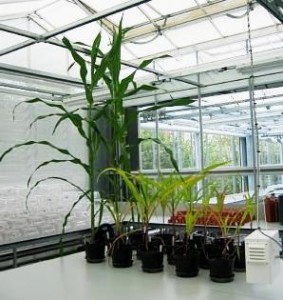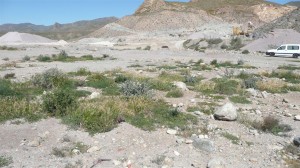
Highly contaminated mine and refinery metal waste sites can remain barren of vegetation for many years. In some cases the only solution has been to dump the contaminated soil into landfill, but it is much more environmentally friendly to regenerate the land.
Professor Leggo and his colleagues at the Department of Earth Sciences, University of Cambridge, are working on a new strategy of soil amendment to greatly enhance the scope of plant growth on poor soils. A critical factor is how to supply sufficient plant nutrients to sustain growth. Biofertilizer seems to be the answer to this problem because, unlike synthetic chemicals, it provides a natural source of plant nutrients by greatly increasing the population of soil nitrifying micro-organisms. It is also becoming a less expensive method of soil fertilization than synthetic agricultural chemicals and will not damage the soil environment.
Their current work is using coal waste as a substrate, as shown in the picture right. They have shown that the biofertilizer is highly effective in producing enhanced growth and quality in six plant species; Miscanthus (Miscanthus giganteus), Ossier Willow (Salix viminialis), Maize (Zea maize), Sugar Beet (Beta vulgaris), Oil Seed Rape (Brassica napus) and Linseed (Linum usitatissimum).
A mixture of organic farm waste and zeolites to increase soil fertility
The biofertilizer, or organo-zeolitic material, is a mixture of organic farm waste and crushed rock containing a common zeolite mineral called clinoptilolite. The farm waste (chicken manure in the present case) is composted together with the crushed rock and ammonium ions (NH4+), produced from the biological decomposition of the farm waste, are adsorbed to the zeolite surfaces. When this mixture is added to a soil, the ammonium ions are oxidized by nitrifying micro-organisms. This results in a large increase in soil nitrification which provides nitrate and other nutritional elements to enhance plant growth and quality.
Work on aqueous leachate from the plant substrates has shown that nitrification is simulated as the soil pore water chemistry shows that nitrifying micro-organisms, under pH controlled conditions, remain fully functional even in metal polluted substrates which are normally highly toxic to cellular organisms. Aqueous leachates from the substrates amended with the bio-fertilizer have cation concentrations that are increased by two orders of magnitude relative to clean unamended soil, demonstrating the increase in abundance of nutritional elements. Furthermore, in moist conditions, zeolite crystal surfaces become covered in biofilm (Leggo and Ledésert, 2006). Recent work has shown that bacteria enclosed in biofilm can survive and remain functional in highly metal polluted environments (Kemner et al., 2005). This, is believed to account for the success had in sustaining the growth of plants (Arabidopsis halleri, Brassica napus and Salix viminalis, etc., ) in sediments that have extreme metal concentrations.

Surprising results in industrial waste sites
Recent work under semi-arid conditions in S.E Spain (Almeria) the biofertilizer has been shown to function in substrates contaminated with industrial waste. This came as a complete surprise as previously these site had remained barren of vegetation. It is thought that early morning dew is adsorbed by the zeolite and re-cycled during the day providing enough soil moisture to allow the micro-organisms to function and sustain plant growth. It therefore appears that the water retaining properties of the zeolite minerals play a critical role in the re-introduction of vegetation in regions of low rainfall.
Work in progress on marginal land in East Anglia, UK has also shown that crops can be grown on what is essentially sand containing very little natural plant nutrient. This work has demonstrate that organo-zeolitic biofertilizers could replace conventional agricultural fertilizer. Countries with zeolitic tuff resources are in a very favorable position as the cost of biofertilizer would be far below that of synthetic chemicals and also be highly beneficial to soil health.


